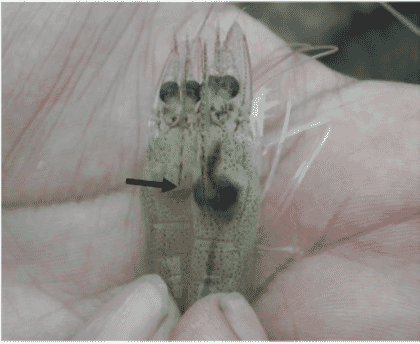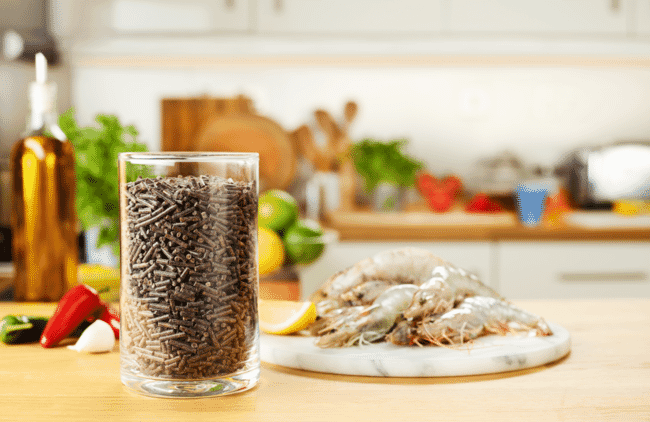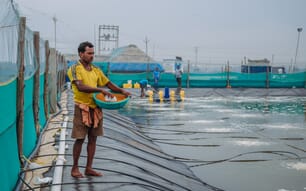
© Professsor DV Lightner
EMS, which is also known as acute hepatopancreatic necrosis disease (AHPND), is one of the major bacterial challenges facing the global shrimp aquaculture sector and there are currently few effective treatments for this disease, other than antibiotics – which are unpopular with consumers and unsustainable in the long term.
However, researchers in Thailand believe that the inclusion of FeedKind in shrimp diets can help to safeguard whiteleg shrimp (Litopeneaus vannamei) against the disease, following trials in which up to 100 percent of the fish meal in shrimp diets was replaced with Methylococcus capsulatus meal protein.
The trials also demonstrated that the novel protein does not affect the growth feed efficiency, or survival of shrimp reared under experimental conditions.
Sign up to this free event here.
Methods
The trial featured four treatments and five replicates of each:
- T1 was a fishmeal-based control containing 15 percent fish meal
- T2 contained 5 percent methanotroph bacteria meal
- T3 contained 10 percent methanotroph bacteria meal.
- T4 contained 15 percent methanotroph bacteria meal.
The shrimp were fed ad libitum for six weeks on the trial diets to assess growth, followed by a single bath challenge with Vibrio parahaemolyticus - the causative agent of EMS/AHPND - and held for a further 15 days to assess survival and resistance.
Results
The researchers noted no significant differences in growth performance of whiteleg shrimp fed feeds containing methanotroph bacteria meal or control diets for six weeks (p>0.05). There were no significant differences in survival, final weight, weight gain, average daily gain, specific growth rate, feed consumption or feed conversion ratio at the end of the study.
In the Vibrio parahaemolyticus challenge, methanotroph bacteria meal in the diet significantly promoted the survival rate, and the reduction of Vibrio sp. in the hepatopancreas of whiteleg shrimp. Immune markers – such as haemocyte counts, phenoloxidase, superoxide dismutase and lysozyme activity – were similar across all groups after the six-week feeding trial.
“The findings show that methanotroph bacteria meal can entirely replace fishmeal in white shrimp diets and the 15 percent inclusion of methanotroph bacteria meal in shrimp diet shows no adverse effects on growth performance, feed utilisation and survival rate as well as improving survival to an AHPND challenge,” the researchers conclude.

© Calysta
Significance
The results of the trials are significant for two main reasons.
The first is that they suggest – for the first time – that FeedKind is a viable replacement for 100 percent of the fish meal in shrimp diets. Fish meal is a finite resource that is already heavily exploited by the aquafeed sector and the use of three quarters of the world’s fish meal supply is one of the major criticisms levelled at the global aquaculture industry – in particular the salmon and shrimp sectors – so substitution with a sustainable alternative is to be welcomed.
It also has advantages over other protein sources, such as soy. As the authors of the paper observe: “An additional benefit of producing methanotroph bacteria meal, is that it utilizes less than 0.01% of the land and around 10% of blue water compared with that used to produce soy protein, enhancing its sustainability credentials.”
The second element of significance is the potential of FeedKind to protect shrimp against AHPND/EMS. This disease is a major concern for shrimp production, caused by the bacterium Vibrio parahaemolyticus, with outbreaks occurring routinely in Southeast Asia shrimp farms, in which mortality rates exceed 70 percent and global annual losses are estimated at more than US$1 billion.
As the authors observe: “In the past antibiotics were commonly used to treat EMS and other Vibrio diseases but these have been widely prohibited (Liu et al. 2017). To enhance shrimp health, many farmers ‘top-dress’ feeds at the farm with additives to improve health outcomes, but this practice is of limited efficacy and is problematic (FAO, 2019). On the other hand, methanotroph bacteria meal is blended in the feed during manufacture at the feed mill, providing a potentially more efficient method for delivering an immune stimulant.”
While promising, the authors add that additional studies are needed to validate the results of the current study under field conditions.
Further information
- The research - plus other cutting-edge, non-medicinal means of tackling major shrimp diseases - was discussed in more detail in a webinar organised by Calysta and The Fish Site on 10 November at 14.00 ICT / 8am CET / 7am GMT.
- A recording of the event will be available from 2pm GMT on 10 November.
- The full study has been published in Frontiers in Marine Science today, under the title "Effects of a single cell protein methanotroph, (Methylococcus capsulatus), bacteria meal in Pacific white shrimp (Litopenaeus vannamei) diet, on growth performance, survival rate and resistance to Acute Hepatopancreatic Necrosis Disease (AHPND), Vibrio parahaemolyticus".
*Calysta and Hatch are both part of Aqua-Spark's investment portfolio, but The Fish Site retains editorial independence.




